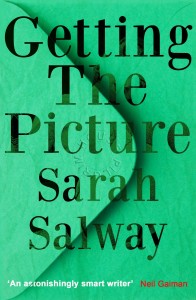It became frightening to step back onto firm ground
 Getting the Picture
Getting the Picture
by Sarah Salway
When new publisher Dean Street Press offered up any of their books for review, I picked this one partly because the synopsis sounded good but mostly because they had a quote from Neil Gaiman on the cover. Not the greatest reason but I think it worked out.
The book opens with Maureen accompanying her model friend Pat to a photographer’s studio. Maureen is married with a young child and the photographer, Martin, specialises in nude portraits – tasteful ones, but nudes all the same – so Maureen is nervous to be there but undeniably attracted to Martin. Cut to 40 years later and Martin is moving into a retirement home. He writes a letter to Maureen to tell her that he picked the same home that her husband George is in, because he wants to finally understand why she went back to her husband after their affair ended.
Apart from the opening and closing chapters, the story is told in a series of letters, e-mails, notes and answerphone messages. It soon becomes clear that Maureen has died and Martin has spent his whole life hopelessly in love with her. What isn’t clear is how long their affair lasted, whether George knew or what Martin really hopes to achieve by getting to know George.
“The worst thing about swings, she remembered, was how, when you were going really high, the ground below seemed to turn to water so it became frightening to step back onto firm ground. You wanted to stay swinging forever, suspended in midair.”
The messages are sent between a fairly large cast of characters and at first I struggled to keep all the names straight as I couldn’t immediately see how they were all connected. Most of the correspondences are one-way. Martin’s letters to Maureen obviously can’t be replied to, or even sent. George’s answerphone messages to his younger daughter Angie reference postcards from her that we never see. George’s irritable letters to Brenda, the manager of the retirement home, lead only to brief notes from her to members of staff. And there is also a series of letters from fellow home resident Florence to her old friend Lizzie, not to mention smatterings of various other correspondences sprinkled in-between.
This isn’t a literary style that lends itself to tense thrilling action and yet I found it a truly compelling read – I found excuses to read whenever possible, including far too late at night. Partly, that’s because dividing the text into sections that are for the most part less than a page long leads to rather a lot of “Oh, just one more”. But I was also intrigued by the growing complexity of the relationships that were unfolding, and particularly the possible outcomes of Martin trying to get close to George and Maureen’s daughters and granddaughter.
“I think you’d like her, Mo. In fact, I’m sure you would. She’s got a bit of your fire about her, once you get past the prickles. But then you had those too, didn’t you? I could never get it right with you. You were always leaving before you even arrived. Like you were just waiting for me to do something wrong so you could tell me you were skipping out.”
Both Martin and George started out as seemingly simple, obvious characters and were gradually revealed as more complex. George is a former accountant, an abider of order and rules and not given to shows of emotion. Martin is artistic, alternately seeking out and avoiding company. He makes friends easily but always has a motive. Because so much of the story is told through his eyes, in the form of his letters to Maureen, it took me a while to realise the degree to which I was being manipulated, the degree to which he, like all narrators, is unreliable.
The book does have a few faults. It sometimes failed the “show don’t tell” rule – a product of the format, perhaps? But I did feel some of the information could have been revealed less clumsily. And some of the characters occasionally veered into caricature. But only briefly.
Once I settled into the style I thoroughly enjoyed this book. To be honest I wish all books I pick up would grip me so well.
Published February 2015 by Dean Street Press.
Source: An e-book was kindly provided by the publisher in return for an honest review.